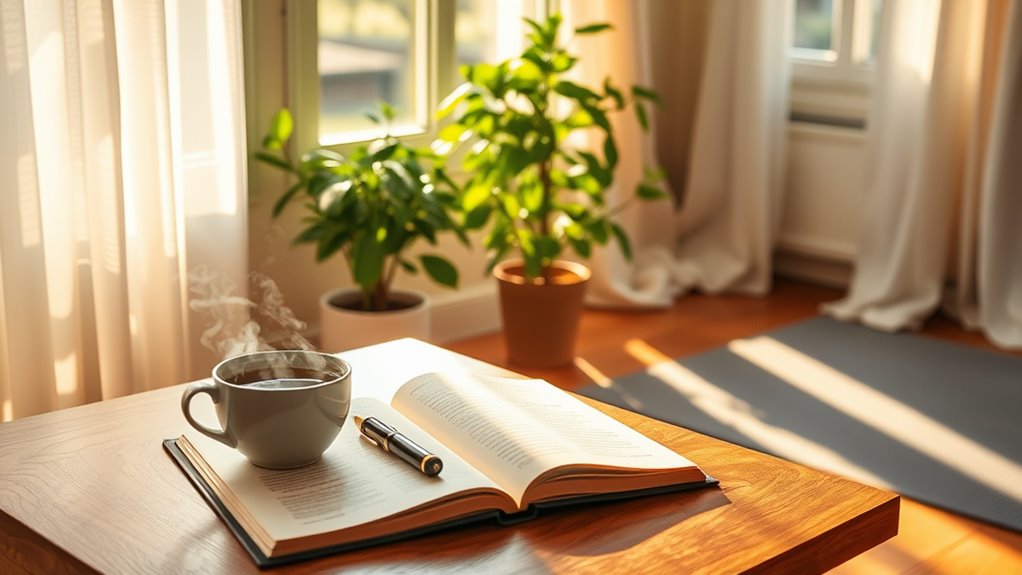This Breathing Technique Will Calm Your Mind in 2 Minutes – Try It Now!
In just two minutes, you can calm your mind and shift your focus using a simple breathing technique. Start by inhaling deeply through your nose for a count of four, then exhale slowly through your mouth for a count of six. Repeat this three times while focusing on your breath. This practice reduces anxiety, enhances concentration, and promotes mindfulness. Want to discover how you can seamlessly integrate these techniques into your daily life? Keep going to learn more!
Key Takeaways
- Find a quiet, comfortable space, free from distractions to prepare for your 2-minute breathing session.
- Inhale deeply through your nose, hold for a count of four, then exhale slowly through your mouth for a count of six.
- Repeat this cycle at least three times, focusing on the flow of your breath to anchor yourself in the present moment.
- Acknowledge any distractions and gently redirect your focus back to your breath to maintain clarity.
- Experience heightened calmness and enhanced focus as you practice this technique regularly, improving overall well-being.
Understanding the Importance of Breath
When you take a moment to focus on your breath, you realize its profound impact on your mental state. Breathing isn’t just a physiological necessity; it’s a gateway to deeper meditation and self-awareness.
By mastering your breath, you gain control over your mind, allowing you to shift from chaos to calm. Each inhalation nourishes your body, while each exhalation releases tension.
This simple act encourages mindfulness, anchoring you in the present moment. As you deepen your breathing, you’ll find it becomes easier to engage in meditation, fostering clarity and focus.
Embrace the rhythm of your breath, and watch how it transforms your thoughts and emotions, empowering you to cultivate profound inner peace. Incorporating breathing techniques into your routine can significantly enhance your relaxation and mindfulness practices.
The Science Behind Breathing Techniques
Although many people view breathing as an automatic process, the science behind breathing techniques reveals their ability to influence both physical and mental health considerably.
When you consciously manipulate your breath, you’re triggering your autonomic nervous system, shifting your body from a state of stress to one of calm. Deep, rhythmic inhalations increase oxygen intake, enhancing your circulation and energy levels.
Conversely, extended exhalations activate the parasympathetic system, promoting relaxation and reducing anxiety. Research shows that these techniques can lower cortisol levels, which are associated with stress. Furthermore, engaging in mindfulness techniques in conjunction with breathing exercises can amplify their calming effects and improve overall well-being.
Preparing for Your Breathing Session
Before you begin your breathing session, it’s vital to create a conducive environment that invites relaxation and focus.
Find a quiet space where distractions are minimal. Dim the lights or draw the curtains to soften the atmosphere. Comfort is essential, so choose a spot that allows you to sit or lie comfortably. You might even want to use a cushion for support.
Next, set aside a dedicated time to avoid interruptions. Turn off your phone and any electronic devices that could disrupt your peace.
If you enjoy soothing sounds, consider playing soft music or nature sounds quietly in the background.
Finally, cultivate an intention for your session; this will help center your thoughts and enhance your experience as you engage in the technique. Breathing techniques are effective tools for reducing anxiety and helping you achieve a state of calm.
Step-by-Step Guide to the 2-Minute Technique
The 2-Minute Breathing Technique offers a quick and effective way to regain your calm.
To start, find a comfortable position, either sitting or standing. Close your eyes and take a deep breath in through your nose, feeling your lungs expand. Hold this breath for a count of four, savoring the stillness.
Next, exhale slowly through your mouth for a count of six, letting go of tension. Repeat this cycle at least three times, allowing your rhythm to settle into a natural pace.
Focus entirely on your breath; notice how it flows in and out. With each exhale, imagine freeing your mind of distractions. Intentional breathing practices like this link breath with meditation techniques for enhanced relaxation and clarity.
After two minutes, open your eyes and appreciate the clarity you’ve achieved. You’re in control.
Tips for Maintaining Focus During Practice
To maintain focus during your breathing practice, start by minimizing distractions in your environment. Choose a quiet space, free of interruptions, and eliminate your phone or any other noise-generating devices.
Here are three tips to keep your mind anchored:
-
Set a Clear Intention: Before you begin, define what you want to achieve in this practice—calmness, clarity, or stress relief.
-
Engage Your Senses: Concentrate on the sensations of your breath, feeling the air fill your lungs and the release that follows.
-
Use a Timer: Setting a timer can help you stay committed and aware, allowing you to focus solely on your practice without glancing at the clock.
Additionally, incorporating structured breathing techniques can enhance your relaxation and stress relief outcomes.
Common Challenges and How to Overcome Them
You might face several challenges while practicing your breathing technique, like distractions that break your focus or difficulty sticking to a routine.
Understanding the nuances of each technique can also be tricky.
Let’s explore how to tackle these common obstacles effectively.
Distractions During Practice
Distractions can sabotage your breathing practice, making it harder to achieve calmness.
It’s essential to recognize these interruptions and learn how to navigate through them. Here are three common distractions you might face:
-
External Noise: Everyday sounds can pull you away from your focus. Consider using earplugs or finding a quieter space.
-
Racing Thoughts: Your mind may wander to to-do lists or worries. Acknowledge these thoughts, then gently return your focus to your breath.
-
Discomfort: Physical unease can break your concentration. Adjust your posture or find a comfortable position to minimize distractions.
Maintaining Regular Routine
Finding a consistent breathing practice can be tricky once you’ve dealt with distractions. You might struggle with finding the right time or place amidst your busy life.
To overcome this, create a dedicated space for your practice; a quiet corner can signal your mind it’s time to focus. Stick to a specific time each day, even if it’s just two minutes to start. Set reminders on your phone to reinforce this habit.
Recognize that life may interrupt your routine, but don’t let it derail your efforts—embrace flexibility. Remember, it’s about progress, not perfection.
When you prioritize your breathing practice, you’ll find it becomes easier to maintain focus and calm, leading you to mastery over time.
Understanding Breathing Techniques
While many people recognize the benefits of breathing techniques, they often encounter challenges that can hinder their practice. Understanding these obstacles is key to mastering your technique.
Here are common challenges and how to overcome them:
-
Distractions: You might feel overwhelmed by your environment. Create a designated space free from interruptions to focus solely on your practice.
-
Restlessness: Your body may resist stillness. Start slowly with shorter sessions and gradually increase your duration to build comfort.
-
Self-doubt: You might question if you’re doing it right. Remember, mastery takes time. Be patient with yourself and embrace the journey.
Integrating Breathing Techniques Into Daily Life
Integrating breathing techniques into your daily life can greatly enhance your mental well-being, especially during stressful moments. Start by incorporating conscious breathing into routine activities. For instance, take a few deep breaths before meals or during commutes.
Set reminders on your phone to pause for a minute and focus on your breath. When facing challenges, practice the 4-7-8 technique: inhale for four counts, hold for seven, and exhale for eight. This method quickly regains focus and calmness.
Additionally, consider pairing your breathing exercises with daily habits, like stretching or meditation, to reinforce consistency. By weaving these practices into the fabric of your day, you’ll cultivate a powerful tool for maintaining mental clarity and composure, ultimately mastering your stress response.
Benefits Beyond Stress Relief
By blending breathing techniques into your daily routines, you’re not just managing stress; you’re releasing a range of additional benefits.
Mastering your breath can transform your mental and emotional landscape, leading to enhancements that empower your life.
-
Heightened Focus: Consistent practice sharpens your concentration, enabling you to tackle challenges with clarity and purpose.
-
Improved Emotional Regulation: You’ll find yourself steering through emotions with greater ease, leading to more balanced interactions and relationships.
-
Enhanced Physical Performance: Optimized breathing can boost your stamina and energy levels, making workouts more effective and enjoyable.
When you harness these advantages, you’re not just calm—you’re thriving.
Integrate these techniques and watch how they elevate every aspect of your life.
Real-Life Success Stories
You might be surprised by how many people have transformed their lives by incorporating breathing techniques into their daily routines.
From stress relief to sharper focus, countless testimonials illustrate the real impact of this simple practice.
Let’s explore some inspiring success stories that highlight these remarkable changes.
Transformative Daily Practice
As individuals embrace the transformative power of breathing techniques, countless real-life stories emerge, illustrating how this practice can shift perspectives and enhance daily living.
You’ve likely heard how others have transformed their lives, and you, too, can experience these profound results:
-
Enhanced Focus: Practicing focused breathing has helped many regain their concentration, avoiding distractions that impact productivity.
-
Heightened Emotional Resilience: Regular breathwork enables individuals to navigate emotional challenges with increased strength and clarity.
-
Greater Self-Awareness: By tuning into one’s breath, people discover deeper insights into their thoughts and behaviors, fostering substantial personal growth.
Integrating these techniques into your daily routine isn’t just beneficial—it’s a gateway to mastering your mind and reshaping your life.
Start today, and witness your own real-life transformation!
Stress Relief Testimonials
Many individuals have turned to breathing techniques to combat stress, and their success stories highlight the remarkable impact of mindful breathwork.
You’ll find that many have experienced profound transformations. One busy executive shared how just two minutes of focused breathing helped him regain composure before high-pressure meetings.
A stay-at-home parent reported using this technique during hectic mornings, leading to a more peaceful household.
And a college student discovered that a few deep breaths before exams dramatically reduced anxiety, allowing her to perform at her best.
These testimonials reveal that by incorporating this simple practice into your daily routine, you, too, can feel more centered and resilient, even amid life’s challenges.
It’s your turn to try these powerful techniques.
Enhanced Focus Experiences
When immersing yourself in breathing techniques, you might be surprised at how they can sharpen your focus and enhance productivity.
Many individuals report transformative experiences. Here are three inspiring success stories:
-
A busy entrepreneur used breathing exercises before meetings and found her ability to think clearly and engage more effectively with clients skyrocketed.
-
A college student transformed his study habits; by incorporating deep breathing, he boosted his concentration and aced his finals.
-
A writer discovered that dedicating just two minutes to breathe deeply before sitting down at his desk improved his creativity and output.
These real-life examples show that mastery of your breath isn’t just calming—it’s a powerful tool for enhanced focus and lasting achievement.
Try it for yourself!
Frequently Asked Questions
Can Children Practice This Breathing Technique Safely?
Absolutely, children can safely practice this breathing technique. You’ll find it helps them manage stress, relax, and build focus. Just guarantee they understand it’s a calming exercise, encouraging mindfulness and a positive mindset.
Is There an Optimal Time of Day for This Exercise?
While you can practice this exercise anytime, morning or before sleep often yields the best results. Engaging in it during these times helps promote a calm mindset, enhancing focus and relaxation throughout your day.
Can I Combine This Technique With Other Relaxation Methods?
Absolutely, you can combine this breathing technique with other relaxation methods. Integrating mindfulness, meditation, or gentle stretching can amplify your overall relaxation experience, enhancing both your focus and tranquility. Experiment to find what works best for you!
How Often Should I Practice This Technique for Best Results?
To achieve ideal results, practice this technique daily. Consistency builds strength and familiarity, allowing you to deepen your focus. Integrate it seamlessly into your routine, and you’ll notice significant improvements in your mental clarity and calmness.
Is It Okay to Practice While Lying Down?
Yes, you can practice while lying down, but make certain you’re comfortable and alert. It’s essential to maintain focus on your breath, so avoid overly relaxed positions that might lead to drowsiness or distraction.





